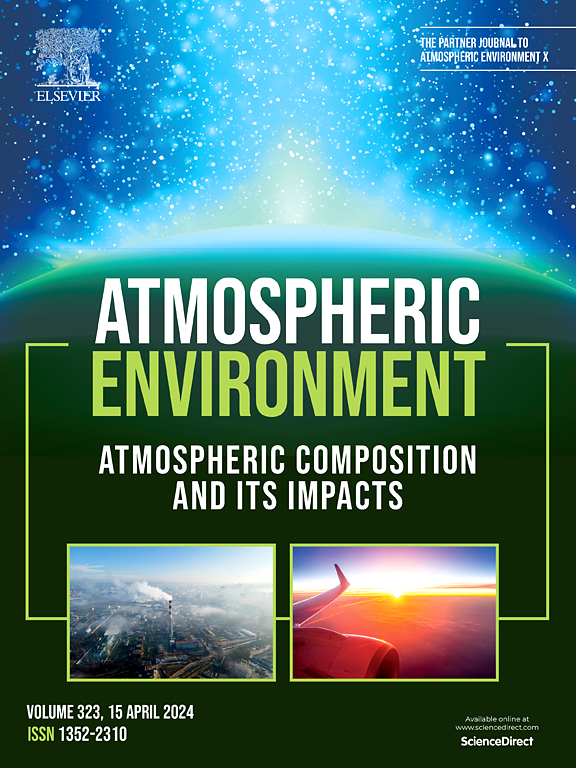Tropospheric ozone precursors over the Indian region: Insights into the shift toward a highly NOx-limited regime
IF 4.2
2区 环境科学与生态学
Q2 ENVIRONMENTAL SCIENCES
引用次数: 0
Abstract
This study comprehensively analyzes trends in tropospheric ozone precursors over the Indian region from 2018 to 2024, focusing on nitrogen dioxide (NO2), formaldehyde (HCHO), and glyoxal (CHOCHO), using TROPOMI onboard Sentinel-5 Precursor satellite datasets. Our results reveal contrasting trends: while HCHO and CHOCHO show consistent increases, NO2 exhibits a slight decrease over the past few years, likely reflecting the impact of emission control measures. The mean growth rate calculated for HCHO Vertical Column Density (VCD) is ∼1.7 % yr−1 and ∼2 % yr−1 for CHOCHO, whereas tropospheric NO2 VCDs show a slower growth rate of ∼ −0.21 %yr−1, indicating a reduction in NOx emissions over recent years. The growth rate of HCHO is consistent with findings from previous studies. However, unlike earlier long-term studies, a recent decline in NO2 has been observed. Long-term OMI dataset measurements are used to corroborate these findings. Analysis of the formaldehyde-to-nitrogen ratio indicates that the Indian mainland region is mostly NOx-limited in nature, and further shifts toward highly NOx-limited ozone production are observed in most parts of the study area. Seasonal patterns show pronounced peaks in NO2 during winter and HCHO and CHOCHO during pre- and post-monsoon seasons, underscoring the significant influence of biomass burning and agricultural activities on precursor levels. The seasonal variation in the Enhanced Vegetation Index (EVI) and fire density was analyzed to assess emissions from biogenic and pyrogenic sources. These findings emphasize the complexity of ozone precursor dynamics in India, highlighting the need for targeted emission controls to mitigate regional ozone pollution.
印度地区的对流层臭氧前体:向高度限制氮氧化物制度转变的见解
本研究利用Sentinel-5 Precursor卫星上的TROPOMI数据集,综合分析了2018 - 2024年印度地区对流层臭氧前体物的变化趋势,重点分析了二氧化氮(NO2)、甲醛(HCHO)和乙二醛(CHOCHO)。我们的研究结果显示了截然不同的趋势:在过去几年中,HCHO和CHOCHO呈持续增长趋势,而NO2呈轻微下降趋势,这可能反映了排放控制措施的影响。HCHO垂直柱密度(VCD)的平均增长率为~ 1.7% yr - 1, CHOCHO的平均增长率为~ 2% yr - 1,而对流层NO2 VCD的增长率较慢,为~ 0.21% yr - 1,表明近年来NOx排放减少。HCHO的生长速度与以往的研究结果一致。然而,与早期的长期研究不同,最近已经观察到二氧化氮的下降。长期OMI数据集测量用于证实这些发现。对甲醛-氮比值的分析表明,印度大陆地区在性质上主要是限制nox的,并且在研究区域的大部分地区观察到进一步向高度限制nox的臭氧生产转变。季节模式显示冬季NO2显著峰值,季风前和季风后HCHO和CHOCHO显著峰值,强调生物质燃烧和农业活动对前体水平的显著影响。分析了植被增强指数(Enhanced Vegetation Index, EVI)和火灾密度的季节变化,以评估生物源和热源排放。这些发现强调了印度臭氧前体动力学的复杂性,强调了有针对性地控制排放以减轻区域臭氧污染的必要性。
本文章由计算机程序翻译,如有差异,请以英文原文为准。
求助全文
约1分钟内获得全文
求助全文
来源期刊

Atmospheric Environment
环境科学-环境科学
CiteScore
9.40
自引率
8.00%
发文量
458
审稿时长
53 days
期刊介绍:
Atmospheric Environment has an open access mirror journal Atmospheric Environment: X, sharing the same aims and scope, editorial team, submission system and rigorous peer review.
Atmospheric Environment is the international journal for scientists in different disciplines related to atmospheric composition and its impacts. The journal publishes scientific articles with atmospheric relevance of emissions and depositions of gaseous and particulate compounds, chemical processes and physical effects in the atmosphere, as well as impacts of the changing atmospheric composition on human health, air quality, climate change, and ecosystems.
 求助内容:
求助内容: 应助结果提醒方式:
应助结果提醒方式:


